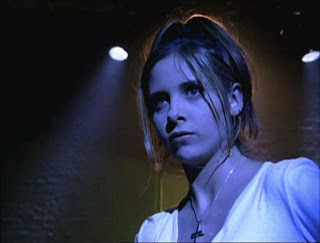The First Episodes
If you’re a fan of the show, I hope you’ll enjoy these looks back, and if you’re not, maybe I’ll incentivize you to give it a shot. If you find yourself someplace in between—e.g., you’re currently watching the show, please note that these posts will include spoilers about the episode(s) they discuss (and sometimes other episodes, too).
And, if you’re not at all interested in Buffy, apologies, but this just isn’t your month. I will be back for a more typical blog post around Halloween, and resume the routine going into November.
I’m going to kick off Buffy month with a look at the two-part launch of the series, "Welcome to the Hellmouth" and "The Harvest."
I watched the two-part premiere of Buffy the Vampire Slayer when it originally aired, in no small part because I was among the relative minority that really liked the 1992 Kristy Swanson movie and its concept. Two big takeaways from that original viewing:
1) I didn’t really like it.
2) Something about that viewing stuck with me and made me want to watch more.
With hindsight, and having watched every episode of this series multiple times, I can understand the two reactions. The first season of Buffy is in many ways rough, as the writing team, the cast, and the network all fumbled to figure out quite what they had in this show. “Welcome to the Hellmouth” and “The Harvest” bleed into one another in ways that make them feel more like a movie than a two-part TV episode, and hinted at the mythology-oriented nature that the show would increasingly lean into, as opposed to the “monster of the week” format fans of shows like this were still more accustomed to. Moreover, there’s an uncomfortable mix of cheesy humor and horror—a hybrid style BtVS would come to own, but that still felt oddly paired, and arguably bad in this first outing.
The episodes center on Buffy’s arrival in Sunnydale, and she both tries to fit into her new high school community and gets introduced to the local cast ofvampires and related heroes, villains, and shades of gray. Her move-in happens to closely coincide with the eponymous Harvest, an event during which vampires will suck a whole bunch of blood on behalf of their entrapped Master, who will derive strength enough from the process to--theoretically--rise to reign over earth.
The Master is in many ways representative of the tradition Buffy stems from and has to overcome in its first season, as the omnipotent, old bad guy looms over most of the action of the show. That he doesn’t survive the first season, and is promptly replaced by the much hipper Spike and far more original Drusilla early in season two really gets things going for the show that Buffy fans love. Season one, and particularly episodes one and two of it, are therefore setup and background necessary to get to the really good stuff.
As a microcosm of that dynamic, though, it’s telling that the second most traditional villain of season one, Luke, is set up as prime villain and dispatched of by the end of the second episode. To the contrary, his running buddy Darla survives--the first vampire we meet in the surprise finish to the cold open of the show, and second-in-command baddie who makes it through half the season (and gets brought back to life for an even better run on the BtVS spin-off Angel). Early on, viewers learn that this show will introduce big, seemingly important personalities, and it will kill them without reservation when the story demands it.
Away from the biggest drama of these first two episodes, we get introductions to Willow, Xander, Giles, and Cordelia, each of whom come across as shells of the characters we’ll grow to love. Those shells are important, though as, like real life first impressions, we get the caricatures before we get to know the people beneath them. For as inelegant as their portraits are in “Welcome to the Hellmouth” and “The Harvest,” there is some joy in looking back at these episodes and acknowledging how wrong the first impressions were.
And that’s the funny thing about these first episodes. They’re necessary, and there are ways in which they’re quite good about exposition, piquing curiosity, and setting up drama to unfold down the road. Just the same, for anyone looking to convert a new fan, or who’s skeptical but has been convinced to watch the show, I feel these episodes are a terrible place to start. Watching season two, then going back for season one—as I, personally, wound up doing, returning to the show and getting hooked on summer reruns after season two had first aired, then scrambling to play catchup—allows some of the show’s most compelling episodes to more organically hook the viewer, and thirst for more of these characters, in a way that makes season one’s unevenness not just tolerable, but a delight to ride the waves of.
“Welcome to the Hellmouth” and “The Harvest” are not necessarily objectively great TV in a vacuum, but a joy to rewatch for the hardcore fan.
That said, next week I’ll delve into the unlikely episode that did hook me, and led to my becoming a fan evermore. Unless you’ve discussed it with me personally, I bet you won’t guess which episode it was.


Comments
Post a Comment